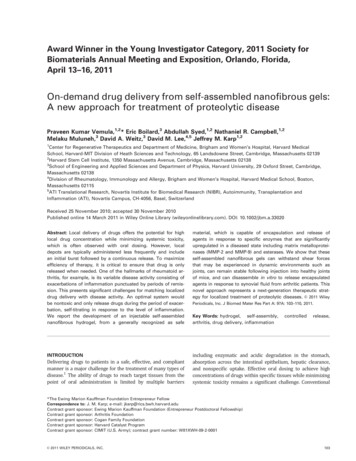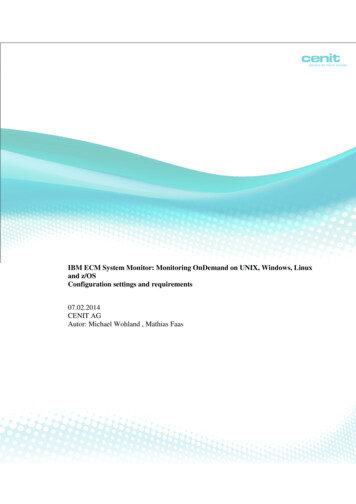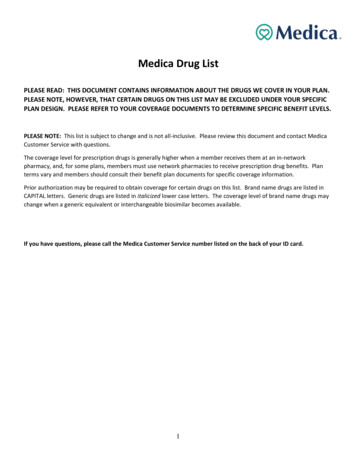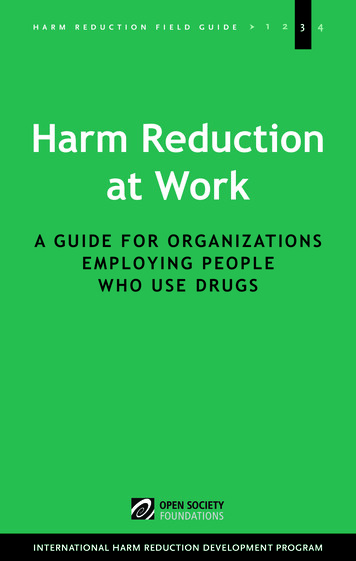
Transcription
Award Winner in the Young Investigator Category, 2011 Society forBiomaterials Annual Meeting and Exposition, Orlando, Florida,April 13–16, 2011On-demand drug delivery from self-assembled nanofibrous gels:A new approach for treatment of proteolytic diseasePraveen Kumar Vemula,1,2* Eric Boilard,3 Abdullah Syed,1,2 Nathaniel R. Campbell,1,2Melaku Muluneh,3 David A. Weitz,3 David M. Lee,4,5 Jeffrey M. Karp1,21Center for Regenerative Therapeutics and Department of Medicine, Brigham and Women’s Hospital, Harvard MedicalSchool, Harvard-MIT Division of Heath Sciences and Technology, 65 Landsdowne Street, Cambridge, Massachusetts 021392Harvard Stem Cell Institute, 1350 Massachusetts Avenue, Cambridge, Massachusetts 021383School of Engineering and Applied Sciences and Department of Physics, Harvard University, 29 Oxford Street, Cambridge,Massachusetts 021384Division of Rheumatology, Immunology and Allergy, Brigham and Women’s Hospital, Harvard Medical School, Boston,Massachusetts 021155ATI Translational Research, Novartis Institute for Biomedical Research (NIBR), Autoimmunity, Transplantation andInflammation (ATI), Novartis Campus, CH-4056, Basel, SwitzerlandReceived 25 November 2010; accepted 30 November 2010Published online 14 March 2011 in Wiley Online Library (wileyonlinelibrary.com). DOI: 10.1002/jbm.a.33020Abstract: Local delivery of drugs offers the potential for highlocal drug concentration while minimizing systemic toxicity,which is often observed with oral dosing. However, localdepots are typically administered less frequently and includean initial burst followed by a continuous release. To maximizeefficiency of therapy, it is critical to ensure that drug is onlyreleased when needed. One of the hallmarks of rheumatoid arthritis, for example, is its variable disease activity consisting ofexacerbations of inflammation punctuated by periods of remission. This presents significant challenges for matching localizeddrug delivery with disease activity. An optimal system wouldbe nontoxic and only release drugs during the period of exacerbation, self-titrating in response to the level of inflammation.We report the development of an injectable self-assemblednanofibrous hydrogel, from a generally recognized as safematerial, which is capable of encapsulation and release ofagents in response to specific enzymes that are significantlyupregulated in a diseased state including matrix metalloproteinases (MMP-2 and MMP-9) and esterases. We show that theseself-assembled nanofibrous gels can withstand shear forcesthat may be experienced in dynamic environments such asjoints, can remain stable following injection into healthy jointsof mice, and can disassemble in vitro to release encapsulatedagents in response to synovial fluid from arthritic patients. Thisnovel approach represents a next-generation therapeutic stratC 2011 Wileyegy for localized treatment of proteolytic diseases. VINTRODUCTIONincluding enzymatic and acidic degradation in the stomach,absorption across the intestinal epithelium, hepatic clearance,and nonspecific uptake. Effective oral dosing to achieve highconcentrations of drugs within specific tissues while minimizingsystemic toxicity remains a significant challenge. ConventionalDelivering drugs to patients in a safe, effective, and compliantmanner is a major challenge for the treatment of many types ofdisease.1 The ability of drugs to reach target tissues from thepoint of oral administration is limited by multiple barriersPeriodicals, Inc. J Biomed Mater Res Part A: 97A: 103–110, 2011.Key Words: hydrogel, self-assembly,arthritis, drug delivery, inflammationcontrolledrelease,*The Ewing Marion Kauffman Foundation Entrepreneur FellowCorrespondence to: J. M. Karp; e-mail: jkarp@rics.bwh.harvard.eduContract grant sponsor: Ewing Marion Kauffman Foundation (Entrepreneur Postdoctoral Fellowship)Contract grant sponsor: Arthritis FoundationContract grant sponsor: Cogan Family FoundationContract grant sponsor: Harvard Catalyst ProgramContract grant sponsor: CIMIT (U.S. Army); contract grant number: W81XWH-09-2-0001C 2011 WILEY PERIODICALS, INC.V103
polymeric drug delivery systems such as implants, injectablemicrospheres, and patches are used by tens of millions of people annually, yet often produce a sharp initial increase in concentration to a peak above the therapeutic range, followed by afast decrease in concentration to a level below the therapeuticrange.1 Additionally, noncompliance with oral medication is aleading cause of hospitalizations. The Holy Grail of drug deliveryis an autonomous system that titrates the amount of drugreleased in response to a biological stimulus, ensuring that thedrug is released only when needed at a therapeutically relevantconcentration. Such a system must rapidly release drug inresponse to fluctuations due to the severity of disease (this isoften reflected by the local inflammatory state), patient-topatient variability, and environmental factors.There exist broad implications for achieving an ondemand drug delivery approach for the treatment of tissuedefects and multiple diseases. One approach toward thisgoal is the design of compounds tailored to release drugs inresponse to the local expression of enzymes that correlatewith the level of inflammation. Inflammatory conditions thatare characterized by the generation of enzymes that destroyextracellular connective tissue—such as rheumatoid arthritis(RA) and wound healing—comprise a particularly attractivefirst application. By targeting other disease-associatedenzyme pathways, this platform would have broad applicability for cancer, ocular disease, oral disease, gastrointestinal disease, and cardiovascular disease. One of the hallmarks of RA, for example, is its variable disease activityconsisting of exacerbations (flare-ups) of the chronic inflammatory joint process punctuated by periods of remission. Asmost disease-modifying drugs in RA demonstrate slow onset(often weeks), treatment options during flare-ups are limited and often use corticosteroids—agents with a plethoraof toxic side effects.2,3 With a prevalence of 1%, RA is themost common form of human inflammatory arthritis. In theUnited States alone, it is estimated that 2.5 million peoplesuffer from the disease, with a monetary cost measured inbillions.4 Although there have been significant advances inbasic science and therapeutics, current treatments remainonly partially effective and plagued by dose- or durationlimiting toxicity. This is exemplified by the removal of drugssuch as Vioxx and Bextra from the market and the Food andDrug Administration (FDA)’s recent rejection of Arcoxia formarket approval. Intraarticular injections may help reducesystemic toxicity given the reduced drug amount requiredto exert local activity within the joint space. Nevertheless,their therapeutic impact is often short lived because ofrapid clearance from the joint (t1/2 ! 0.1–6 h),5 and existingdrug delivery depots have poor physical stability within thejoint.5Thus, the use of a long-acting intraarticular drug deliverymethod that titrates release to match disease activity andaccommodates a large quantity of drug would represent anattractive paradigm shift. Importantly, published literature hasdemonstrated that specific enzymes are significantly upregulated within arthritic joints such as matrix metalloproteinases 2and 9 (MMP-2 and MMP-9),6 and their expression and concentration correlate with the degree of synovial inflammation.7104VEMULA ET AL.Current approaches for releasing drugs in response to specificstimuli (e.g., MMP-sensitive crosslinked hydrogels) show promise,8–11 but typically only accommodate low concentrations ofdrugs and crosslinked gels present slow diffusion times.We have focused our attention on the development ofenzyme-responsive self-assembled nano/microfibrous hydrogels that can easily be injected into the articular space, yet aremuch larger than free drug, which should increase residencetime by preventing rapid clearance by the lymphatic system.The inherent nanometer-scale features of this self-assemblednoncrosslinked hydrogel maximize the interaction withspecific enzymes for rapid disassembly and drug release. Inthis proof-of-concept work, we have identified an amphiphiliclow-molecular-weight agent from the United States FDA’sgenerally recognized as safe (GRAS) list of agents that canserve as a highly efficient hydrogelator to entrap and releasemodel agents in response to enzymes that are present duringinflammatory conditions. In particular, we have shown thatgels made from ascorbyl palmitate (Asc-Pal) can encapsulatemodel agents, withstand shear forces that may be experiencedin dynamic environments such as joints, remain stable following injection into healthy joints of mice, and can disassemblein vitro to release encapsulated agents in response to synovialfluid from arthritic patients.MATERIALS AND METHODSGeneral informationAsc-Pal and matrix metalloproteinases were purchased fromSigma Aldrich (St. Louis, MO). The Novozyme 435 (lipase Bfrom Candida antarctica) and Lipolase 100L were obtainedfrom Novozymes through Brenntag North America. 1,10 -Dioctadecyl-3,3,30 ,30 -tetramethylindodicarbocyanine, 4-chlorobenzenesulfonate salt (DiD) dye was purchased from Invitrogen. All other chemicals and reagents were purchased fromSigma Aldrich (St. Louis, MO) and were used without furthermodification or purification unless otherwise specified.Preparation of gelsGiven that Asc-Pal has not previously been shown to selfassemble into hydrogels, multiple solvent systems wereattempted. Typically, solvents (0.2 mL) were added to a glassscintillation vial with the gelator (0.5–5 wt/vol %) and sealedwith a screw cap. The vial was heated to !60–80" C until thegelator was completely dissolved. The vial was placed on astable surface and allowed to cool to room temperature. Typically after 15–45 min, the solution was transitioned into a viscous gel. Gelation was considered to have occurred when nogravitational flow was observed upon inversion of the glassvial, and resulted hydrogels are injectable.Scanning electron microscopyFor electron microscopic analysis of gel morphology, solid gelsderived with unhindered shrinkage (xerogels) were preparedby lyophilizing the gels (which were prepared as describedabove). Small amounts of xerogel were placed on carbon tapeattached to aluminum grids and coated with a thin layer of goldusing a sputtering machine. Those aluminum grids weredirectly imaged under scanning electron microscopy (SEM).ON-DEMAND DRUG DELIVERY FROM SELF-ASSEMBLED NANOFIBROUS GELS
ORIGINAL ARTICLEUV–vis spectroscopyUV–visible spectra of the amphiphile gelators and DiD dyewere recorded using a CARY100BIO spectrophotometer. Inall experiments, solutions were observed in a quartz cuvettewith a 1-cm path length.X-ray diffractionX-ray diffraction (XRD) measurements were conducted usinga Bruker AXS D-8 Discover with a GADDS diffractometerusing graded d-space elliptical side-by-side multilayer optics,monochromated Cu-Ka radiation (40 kV, 40 mA), and imaging plate.Ab initio calculationsAll ab initio Hartree–Fock calculations reported in this workwere performed using the Gaussian 03 suite program.12 Thegeometry of Asc-Pal was located and optimized at the levelof restricted Hartree–Fock using the 6-31G* basis set. Thestructure of Asc-Pal was completely optimized without anysymmetry restrictions. Vibrational frequency calculationswere performed to confirm that they converge to true minima by diagonalization of their Hessian (force constant)matrixes at the same level to ensure that all frequencieswere genuine.Release kineticsDiD-encapsulating Asc-Pal self-assembled gel fibers (200lL) were suspended in PBS (800 lL), and either MMP-2,MMP-9, or lipase enzyme (100 ng/mL) was added followedby incubation at 37" C. At each time point, an aliquot (10lL) from the supernatant above the fibers was dissolved inDMSO (90 lL), and the released DiD was quantified by UV–vis spectroscopy at the characteristic wavelength of 655 nm.After withdrawing each aliquot, the incubation medium wasreplenished with PBS (10 lL). To examine the potential foron-demand drug release, enzyme-containing media wereremoved after a 4-day incubation and replenished with PBS.After 7 days, fresh enzyme was added.Human synovial fluid analysisHuman knee synovial fluids were obtained as discardedmaterials from patients with RA undergoing diagnostic ortherapeutic arthrocentesis. Arthritis diagnosis was ascertained by an American Board of Internal Medicine certifiedRheumatologist and/or by review of laboratory, radiologic,and clinic notes and by applying ACR classificationcriteria.13 All studies received Institutional Review Boardapproval.Stability of self-assembled gel fibers in miceSix 9-week-old Balb/C mice housed in a specific pathogenfree animal facility at the Dana-Farber Cancer Institute wereused for these studies. All procedures were approved by theInstitutional Animal Care and Use Committee of the DanaFarber Cancer Institute (Boston, MA). Self-assembled fiberswere redispersed in PBS solution and injected using a 27gauge needle into the ankles of Balb/C mice. Animals weresacrificed after 8 weeks and thick 20- to 30-lm cryosectionsJOURNAL OF BIOMEDICAL MATERIALS RESEARCH A MAY 2011 VOL 97A, ISSUE 2were obtained. Care was taken to avoid the use of alcoholsor organic solvents that could dissolve the gels and compromise visualization of intact gel fibers. Thus, unstained sections were examined for fluorescence from DiD dye. For theevaluation of fiber disassembly by murine arthritic jointproteins, we prepared lysates in the absence or presence ofprotease inhibitor cocktail (Sigma) as described14 usingarthritic ankles from 7-week-old K/BxN mice.15RESULTS AND DISCUSSIONOne of the greatest challenges in the field of drug deliveryis that many drugs have been deemed unsuitable for oraldosing given their systemic toxicity profile. Often this is dueto the high concentrations required to produce a therapeutic effect at a localized site. Localized delivery of drugsoffers significant advantages for the treatment of many diseases; however, there have been very few approved implantable or injectable local drug delivery systems. Drug deliverydepots that can effectively achieve high concentrations ofdrugs within specific environments while limiting systemictoxicity would be useful for multiple applications. Selfassembled gels from amphiphilic gelators represent anattractive platform for localized controlled drug deliverygiven their inherent nanofibrous morphology with a highsurface area to volume ratio that permits ease of injectionand helps to promote rapid drug release in an enzyme-responsive manner. Although there are many approaches todevelop self-assembled gels through synthesis of novel gelators, we propose a conceptually novel approach throughselecting amphiphiles from agents that have already beenused in humans with an established safety profile. Specifically, we selected an agent from the FDA’s list of GRASagents that we believed was a candidate hydrogelator capable of forming gels that could be disassembled in responseto enzymes that are typically upregulated in proteolytic diseases including MMPs and esterases. We selected Asc-Palgiven that it exhibits both hydrophobic and hydrophilicdomains (amphiphilic) and has potential for self-assemblygiven its ability to form noncovalent interactions includingvan der Waals forces and hydrogen bonding.Design and gelation studies of Asc-Pal amphiphileAsc-Pal, also known as 6-O-palmitoyl ascorbic acid (seeFig. 1), was selected as a GRAS-based amphiphilic gelator.Asc-Pal encompasses the structural features required for theself-assembly, for example, a polyhydroxyl sugar head groupfor the formation of a hydrogen-bonding network, and apolymethylene hydrocarbon chain for van der Waals interactions. These groups synergistically act to form strong intermolecular interactions that have the potential to inducegelation (formation of nano/microfibrous structures). Inaddition, Asc-Pal has an ester linkage that enables cleavageby esterases and MMPs that are present during an inflamedcondition (Fig. 1). Use of self-assembled gels from amphiphilic gelators provides an opportunity to avoid the undesired burst release16 that is often the characteristic limitation of drug delivery devices.17 Asc-Pal showed excellentgelation ability as assessed in a wide range of solvents at105
FIGURE 1. (A) Chemical structure of Asc-Pal amphiphile, and schematic representation of the encapsulation of dye during the self-assembly process. (B) Schematic of enzyme-triggered drug (dye) release through degradation of self-assembled fibers. [Color figure can be viewed in theonline issue, which is available at wileyonlinelibrary.com.]low concentrations (2–5 wt/vol %) as shown in Table I.Additionally, a dye could be added during the assembly process as a model drug, enabling direct imaging of the fibers.The morphologies of the self-assembled hydrogels wereexamined using SEM and fluorescence polarizable opticalmicroscopy. Investigation of the hydrogels formed fromAsc-Pal with SEM showed that hydrogels form fibrous structures with fiber thicknesses of 20–300 nm and fiber lengthsof several microns [Fig. 2(A)]. The anisotropic nature ofintermolecular interactions between amphiphile moleculesis supported by the high aspect ratios of the gel fibers. Dyeencapsulating fibers were rinsed with excess PBS to removeunencapsulated dye, and subsequent fluorescence microscope images of the fibers [Fig. 2(B)] indicated that the dyewas encapsulated within the fibers.To propose a model for self-assembly of amphiphiles inaqueous solution, we calculated long distance spacings (d)from the XRD patterns of the hydrogel of Asc-Pal. Weobtained optimized geometries and calculated the length ofamphiphile using ab initio calculations and by combiningthese results with the data from XRD. Through this, we propose a model for the self-assembly of Asc-Pal. XRD experiments [Fig. 3(A)] yielded a long distance spacing of 4.39 nmfor hydrogel fibers of Asc-Pal, which is higher than themolecular length (2.60 nm from optimized structure) of AscPal and lower than double the extended molecular length.Thus, we postulated that a highly interdigitated bilayer-likestructure is present at the molecular level [Fig. 3(B)].Enzyme-responsive fiber disassembly and release of dyeIn addition to rapid clearance of drugs from joints, which isa major limitation of intraarticular injections,18 conventionaldrug delivery systems that aim to control drug release typically result in an initial burst17 followed by continuousrelease, which is not ideal for many applications involving106VEMULA ET AL.fluctuations in the disease state (i.e., drug continues torelease even when it is not needed). To address these limitations, it is important to develop a drug delivery systemthat may reside within the joint and release drugs inresponse to the status of the disease. In this work, wedemonstrate the encapsulation of a model dye in Asc-Palhydrogel, which upon enzyme-mediated gel degradationreleases the encapsulated dye at model physiological conditions in a controlled manner. Previously, we have demonstrated the enzyme-triggered controlled delivery of hydrophobic drugs using molecular hydrogels.19 To investigateenzyme-responsive release from Asc-Pal-based self-assembledgel fibers, DiD (absorption kmax of 655 nm) was selected as amodel small molecule (MW ¼ 1052) for encapsulation.Specific enzymes are significantly upregulated within arthriticjoints,6 and their expression and concentration correlate withthe degree of synovial inflammation.7 Thus, we have testedthe ability of self-assembled gel fibers to release an encapsulated payload in response to the enzymes that are expressedTABLE I. Gelation Ability of GRAS-Amphiphile Asc-Pal inVarious SolventsSolventAsc-PalWaterBenzeneTolueneCarbon lformamideDimethylsulfoxideGGGGGSSPPSolutions were considered to gel only if upon inversion of the glassvial the solution did not flow in response to gravity.G, gel; P, precipitate; S, soluble.ON-DEMAND DRUG DELIVERY FROM SELF-ASSEMBLED NANOFIBROUS GELS
ORIGINAL ARTICLEFIGURE 2. (A) Scanning electron micrograph and (B) brightfield and fluorescence optical images of dye (DiD)-encapsulating self-assembledfibers from Asc-Pal. [Color figure can be viewed in the online issue, which is available at wileyonlinelibrary.com.]within arthritic joints. DiD-encapsulating gel fibers were dispersed within PBS and incubated at 37" C with either lipase(esterase), or MMP-2, or MMP-9 enzyme (100 ng/mL). Atregular intervals, aliquots of samples were collected, andrelease of the dye was quantified using absorption spectroscopy. Plotting cumulative release of the dye (%) versus time[Fig. 4(A)] revealed that lipase and MMPs trigger fiberdisassembly to release the encapsulated dye, whereas gels inPBS controls remained stable and did not release significantamounts of dye. Additionally, through thin-layer chromatography, we identified the presence of ascorbic acid and palmiticacid (confirmed by comparing Rf values by cospotting withauthentic samples of ascorbic and palmitic acids) only in gelsolutions that contained enzymes. We have shown that gelsin PBS remain stable for at least 3 months, indicating thatthe presence of enzymes is required for gel disassembly andthe release of encapsulated agents. This result confirms theabsence of loosely bound dye on the surface of the gel fibers.In the absence of enzymes, mechanical agitation of the fibersthrough rigorous vortexing did not induce the release of dye,indicating that agents incorporated within the fibers remainstably entrapped. Importantly, in the present system, we didnot observe burst release (Fig. 4), which is consistent withself-assembled prodrug-based gels that we have previouslyFIGURE 3. (A) X-ray diffraction plot of self-assembled hydrogels made from Asc-Pal. (B) Top: Optimized structure of Asc-Pal; bottom: postulatedmode of self-assembly of Asc-Pal within an aqueous solution. [Color figure can be viewed in the online issue, which is available atwileyonlinelibrary.com.]JOURNAL OF BIOMEDICAL MATERIALS RESEARCH A MAY 2011 VOL 97A, ISSUE 2107
FIGURE 4. DiD release from Asc-Pal self-assembled gel fibers in response to lipase, MMP-2, and MMP-9 at 37" C in vitro. (A) Enzyme was addedon day 0, and release kinetics were continuously monitored. (B) After 4 days of enzyme addition, media were changed to remove the enzyme(dotted arrow); on day 11, fresh enzyme was added (solid arrow), triggering the release of dye. [Color figure can be viewed in the online issue,which is available at wileyonlinelibrary.com.]synthesized.19 To investigate the potential for on-demand disassembly, following a 4-day incubation with enzyme (MMP-2,MMP-9, or lipase) containing media that triggered disassembly of fibers, media were replaced with PBS, which halted thedisassembly of fibers and the release of dye. After a subsequent 7-day incubation with PBS, enzymes were added tothe suspended fibers, triggering disassembly and the releaseof the encapsulated dye [Fig. 4(B)]. These results clearly suggest that Asc-Pal self-assembled fibers respond to proteolyticenzymes that are present within arthritic joints and releaseencapsulated agents in an on-demand manner.Arthritic synovial fluid induces fiber disassemblyTo investigate whether arthritic synovial fluid could triggerfiber disassembly, leading to the release of the encapsulateddye, we obtained synovial fluid from arthritic human joints.DiD-encapsulating fibers were incubated in arthritic synovial fluid at 37" C, and the release of dye was quantifiedover a period of 15 days. Plotting cumulative release of thedye (%) versus time [Fig. 5(A)] revealed that synovial fluidtriggers fiber disassembly leading to the release of the dye.To determine whether proteases that are present in arthriticjoints were responsible for fiber disassembly, we preparedlysates from arthritic joints of mice in the presence andabsence of protease inhibitors. Incubation of self-assembledgel fibers with these lysates was used to help reveal therole of arthritis-associated proteases. The presence of protease inhibitors significantly reduced fiber disassembly anddye release, thus demonstrating that the presence ofenzymes was critical for promoting the release of agentsfrom gels formed from Asc-Pal [Fig. 5(B)].Fiber stability in joints under nonarthritic conditionsTo investigate the stability of fibers in the absence ofinflammation, fibers were injected into the joints of healthymice using a small-bore (27 gauge) needle. Eight weekspostimplantation, the ankles of mice were sectioned andimaged with optical and fluorescence microscopy to observeFIGURE 5. (A) Synovial fluid collected from arthritis patients mediated fiber disassembly and dye release over a 15-day period, whereas dye wasnot released from gels incubated with PBS. (B) Gel fibers were incubated with synovial lysates prepared from ankle tissue of arthritic mice with andwithout protease inhibitors. The presence of protease inhibitors significantly reduced the release of dye from the Asc-Pal self-assembled gel fibers.108VEMULA ET AL.ON-DEMAND DRUG DELIVERY FROM SELF-ASSEMBLED NANOFIBROUS GELS
ORIGINAL ARTICLEFIGURE 6. Fluorescence optical microscope images of harvested ankles of healthy mice 8 weeks following local injection. Fluorescence was notdetected in joints that were injected with gel fibers in the absence of encapsulated dye (not shown). [Color figure can be viewed in the onlineissue, which is available at wileyonlinelibrary.com.]the presence of fibers. Images of tissue sections (Fig. 6)revealed that DiD-encapsulating fibers were present, suggesting the potential for long-term hydrolytic stability of thefibers in vivo.Reversible self-assembly of fibersMaterials that are injected into the joint space experiencecyclical mechanical forces during ambulation; thus, it isimportant that materials that are injected into the joint canwithstand these forces and retain their characteristic material properties such as mechanical strength and morphology.To investigate the impact of relevant mechanical forces onthe Asc-Pal fibers, we subjected gel nanofibers to cyclicalshear forces and examined their resulting rheological properties using a rheometer equipped with a parallel-plategeometry [Fig. 7(A)]. The elastic/storage modulus G0 wasindependent of frequency and was much higher than theviscous modulus G" over the frequency range (0–12 rad/s)examined [Fig. 7(A)]. This type of response is typical ofgels,20,21 as it shows that the sample does not change itsproperties or ‘‘relax’’ over long time scales. The value of G0is a measure of the gel stiffness, and its value here ( 1000Pa) indicates a gel of slightly higher strength than collagenplatelet gels.22 The mechanical properties and strength ofthese gels are comparable with earlier reported selfassembled peptide gels that are being examined as possibleinjectable joint lubricants for the treatment of osteoarthritis.23 Frequency sweeps conducted before/after multiplecycles (1, 20, and 40) of a high shear stress were used tomeasure G0 (storage modulus). Interestingly, no significantdifferences were observed after 40 cycles [Fig. 7(B)], indicating that the gel fibers retain their mechanical strength.These results indicate that self-assembled fibers made ofAsc-Pal have the potential to retain their morphology andmechanical properties even under the dynamic forces thatmay be experienced during ambulation.24,25CONCLUSIONHerein, we demonstrated that an amphiphilic GRAS agent,Asc-Pal, represents an efficient low-molecular-weight hydrogelator capable of encapsulation of model agents throughself-assembly within an aqueous solution. The resultant gelshould exhibit minimal toxicity given that it disassemblesinto readily metabolized ascorbic and palmitic acids. Themolecular properties of the self-assembled gels wereassessed through analysis with XRD and theoretical calculations. Upon self-assembly, Asc-Pal formed a nano/microfibrous hydrogel that could easily be injected through aFIGURE 7. Dynamic rheology of Asc-Pal fibrous hydrogels assessed with a parallel-plate rheometer. (A) Storage modulus, G0 , and viscous modulus, G", over a frequency range of 0–12 rad/s. (B) Frequency sweeps conducted before/after multiple cycles of a high shear stress to measure G0 .[Color figure can be viewed in the online issue, which is available at wileyonlinelibrary.com.]JOURNAL OF BIOMEDICAL MATERIALS RESEARCH A MAY 2011 VOL 97A, ISSUE 2109
small-bore needle (27 gauge), and dynamic rheology studiessuggested that fibers retained their mechanical propertiesunder multiple cycles of compression. The Asc-Pal gelsremained stable within normal joints for at least 8 weeks,yet disassembled and released encapsulated agents inresponse to enzymes that are known to be overexpressedduring flares of RA, and in the presence of synovial fluidfrom arthritic human joints. Further in vivo experimentsusing arthritic mice are currently underway. The use ofself-assembled gels developed from low-molecular-weighthydrogelators to locally deliver drugs in an enzyme-responsive manner should have broad implications for the localized treatment of many proteolytic diseases. For example,drug release may be triggered for treatment of tumors as aresult of the enzymatic action of tumor cell-associatedproteases26,27 such as plasmin, or drug may be programedto release in selected sites of the gastrointestinal tractunder the influence of specific digestive enzymes.28,29ACKNOWLEDGMENTThe authors thank Brenntag North America for the gift ofenzyme samples.REFERENCES1. Langer R. Where a pill won’t reach. Sci Am 2003;288:50–57.2. Wolfe F, Caplan L, Michaud K. Treatment for rheumatoid arthritisand the risk of hospitalization for pneumonia:
tained by an American Board of Internal Medicine certified Rheumatologist and/or by review of laboratory, radiologic, and clinic notes and by applying ACR classification criteria.13 All studies received Institutional Review Board approval. Stability of self-assembled gel fibers in mice Six 9-week-old Balb/C mice housed in a specific pathogen-










